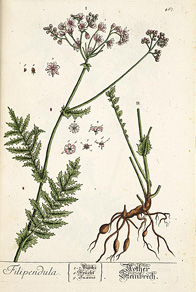Soothing Meadowsweet
By Audrey Stallsmith

Through grass, through amber'd cornfields, our slow Stream--
Fringed with its flags and reeds and rushes tall,
And Meadowsweet, the chosen of them all
By wandering children, yellow as the cream
Of those great cows--winds on as in a dream. . .
"Meadowsweet" by William Allingham
I recently posted a photo of an unidentified plant a friend had given me, which had heads of cream-colored flowers and ferny foliage. And I was somewhat embarrassed to be told it was actually a different version of a perennial I'd already grown for years.
In my defense, I will point out that my filipendula--probably an ulmaria type, though I'm not sure of that--has lobed leaves and double flowers. The newcomer, on the other hand, sports single flowers and ferny foliage and is probably Filipendula vulgaris. Both are meadowsweets, however, and originated in the fields of Europe and western Asia.
They are probably most famous for the fact that aspirin is a synthetic version of the salicin originally derived from them. Before Bayer, however, people just chewed meadowsweet roots to soothe their headaches and arthritis, or to break their fevers.
But the herb would be comforting even without the salicin, as a symbol of the "what is so rare" month. Brideshead Revisited speaks of "a cloudless day in June, when the ditches were creamy with meadowsweet and the air heavy with all the scents of summer." In his poem "Adlestrop," Edward Thomas also wistfully recalls a day in June.
And willows, willow herb, and grass,
And meadowsweet, and haycocks dry,
No whit less still and lonely fair
Than the high cloudlets in the sky.
Filipendula derives from filium ("thread") and pendula ("hanging"), in reference to the tubers that dangle from the roots. And ulmaria means "elm-like," according to Gerard for the "likenesse that the leaves have with the Elme leaves." (Both appear somewhat wrinkled.) The herb has sometimes been called spiraea instead, to designate a plant often "spiraled" into wreathes or garlands--in its case, bridal garlands.
So meadowsweet has also been known as bridewort, queen of the meadow, dolloff, and--in Chaucer's Knight's tale--mead wort. There it was an ingredient in a mead called "save." It was also--along with vervain and watermint--one of three herbs sacred to the Druids.
In addition to being dried for potpourri, meadowsweet flowers have added an almond flavor to cooked fruits, alcoholic beverages or vinegars. The herb should probably be avoided, however, by children with viruses, asthmatics, and anybody else to whom aspirin might also be dangerous.
For the rest of us, the painkiller derived from meadowsweet has often "saved" the day. The plant's scent also made it a favorite strewing herb in the Middle Ages. Gerard wrote that "the leaves and floures farre excell all other strowing herbes, for to decke up houses, to straw in chambers, halls, and banqueting houses in the Summer time; for the smell thereof makes the heart merrie. . ." He also pointed out that meadowsweet wouldn't cause headache or nausea, as some more overpowering odors might.
Many of us wish June could wind on forever like that "slow stream" in Allingham's poem. In its later lines, he writes of "an ivied Hall."
There, once upon a time, the heavy King
Trod out its perfume from the Meadowsweet,
Strown like a woman's love beneath his feet.
Filipendula image is from Herbarium Blackwellianum by Elisabeth Blackwell, courtesy of the Missouri Botanical Garden.








